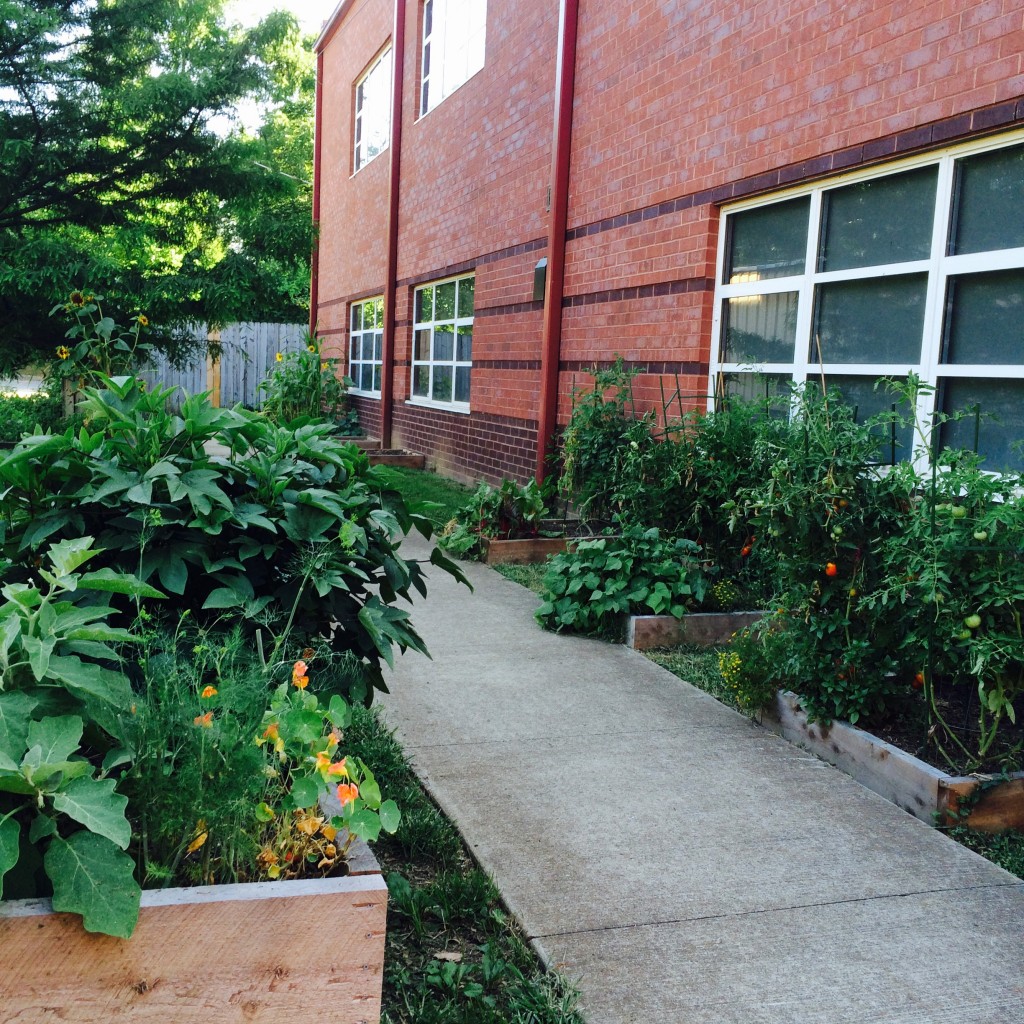One of the questions we are asked most frequently is, “What happens to your school garden in the summer?” School gardens often become weedy jungles during the summer months when students are away, but with a little planning ahead, this can be avoided.

Pollinators are busy in the school garden during the summer; when children return in fall, they will save the seeds from this sunflower for next year’s planting.
Every school community is different, which means that the solutions to garden maintenance will be different, too. At Plant the Seed, we have worked with a variety of situations over the years in various school and community gardens, and we have learned that there are many ways to approach the summer months. Here are a few things to consider to keep your garden growing and ready for students when they return in the fall:
- Who will harvest the produce?
Is there a summer camp or other summer activity happening at the school? If so, campers may enjoy harvesting or weeding as a part of summer programming. Are there teachers who would like to harvest herbs and produce? What about community members or families? Offering a share of the produce can be a great incentive to get volunteer helpers involved, which brings us to one of the most important considerations….
- Who will maintain the garden?
This is probably the hardest and most important question to answer before school is out for the summer. Notice the word “before.” Have your volunteer plan in place by the time children leave for the summer. May can be a very busy month, so it is a great idea to begin your summer plan when you are planting in early spring. Build on the excitement of volunteers and ask for commitments to help with summer watering and weeding. If you are relying on family or community volunteers, sites like signupgenius.com offer free, simple tools to organize volunteer schedules.
Having a lead garden coordinator helps eliminate confusion about who is responsible for the garden, but there is often more work than one person can handle. Consider teachers, parents, and nearby community members who might be willing to weed and water in exchange for fresh veggies. In the absence of a lead coordinator volunteer, many school gardens opt to pay a stipend to a garden manager to ensure consistent maintenance and coordination of volunteers. This position could be funded through a PTO organization or through many available school garden grants.
- How much time does it take to maintain a school garden?
The amount of time your garden requires for maintenance depends on many factors. Do you have raised beds, or in-ground plantings? Do you have an orchard or wildflower area? Who cuts the grass?
At many school sites, there is a landscaping maintenance crew that is contracted to mow grass and trim weeds. If this is the case at your school, design your garden with this in mind. Raised beds are easy to keep weeded, and they protect your plants from accidentally being trimmed by a landscaping crew. In-ground plantings can be harder to maintain, as bermudagrass and other weeds can creep into your vegetable plantings, so design your garden to be low-maintenance.
For a typical raised bed school garden, expect to visit the garden for maintenance at least twice a week to weed and water if necessary. During hot, dry periods or times when you are germinating seeds, more frequent visits will be needed.
- If we harvest the summer plants, what will be left for students when they return?
When harvesting a school garden, consider picking just enough produce to keep plants productive, while leaving as many veggies as possible for students to harvest when they return. Plants like okra, zucchini, and cucumber must be picked throughout the summer so that they will continue to produce, and basil tops can be picked regularly to prevent flowering and encourage full growth. Tomatoes are a favorite in the school garden because early-ripening fruits can be picked by volunteers, but there are usually plenty of tomatoes still ripening when students return to classes in early August.
Fall is also the perfect time for planting cool-season brassicas and carrots for overwintering, so any space left vacant by harvested summer plants can be designated for planting as soon as students return. Take advantage of all growing seasons by covering a raised bed with a low tunnel, or build a cold frame to grow lettuces throughout the winter.

The low-maintenance raised bed garden at Dan Mills Elementary is growing beautifully. Produce is minimally harvested by staff, families, and volunteers, but most of the harvest will be used in the after school garden program beginning in August.
Even with the most regular attention, many gardens could still use some refreshing at the end of the growing season, so consider organizing a volunteer garden cleanup day at the end of the summer or just after school starts. This is a great opportunity to engage families and find new volunteers. With a little planning and regular maintenance visits, your school garden will be in great shape to welcome staff, children, and families into a new school year.

